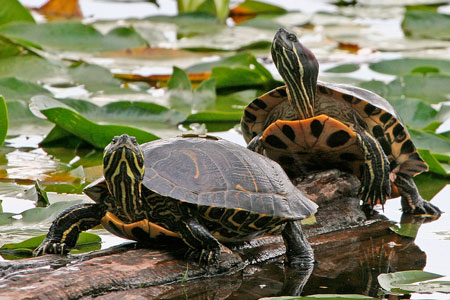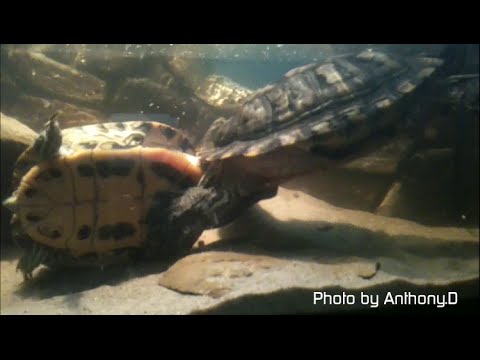Red-eared slider turtles mate through a process called copulation, where the male mounts the female and inserts his penis into her cloaca. This mating process can be quite aggressive, with the male biting and scratching the female to secure his position.
Red-eared slider turtles are known for their vibrant red stripes on the sides of their heads and their distinctive mating behavior. These turtles are native to the southern United States, but they have become popular pets worldwide due to their hardy nature and striking appearance.
Understanding how red-eared slider turtles mate is essential for those interested in breeding these fascinating creatures or simply observing their natural behaviors. We will explore the mating habits of red-eared slider turtles and provide insights into their reproductive process. Whether you are a turtle enthusiast or a curious observer, this information will offer valuable insights into the intriguing world of red-eared slider turtle mating.

Credit: naturemappingfoundation.org
Red Eared Slider Turtles Mating Habits
Mating Season
Red Eared Slider Turtles typically mate in the spring and summer months.
Male Turtle Behaviour
Male Red Eared Slider Turtles display courtship behavior by swimming around the female and bobbing their heads.
Female Turtle Behaviour
Female Red Eared Slider Turtles may show signs of receptivity by stretching their necks and fluttering their limbs.
The Mating Process
Red-eared slider turtles are fascinating creatures, and understanding their mating process can provide valuable insights into their behavior. The mating process involves various courtship rituals, the act of mating, and reproductive strategies that are essential to the species’ survival. Let’s delve into the intriguing world of red-eared slider turtle mating.
Courtship Rituals
Red-eared slider turtles engage in elaborate courtship rituals before mating. The male turtle often swims around the female, using head bobbing and gentle nudging to get her attention. This behavior is crucial in establishing the male’s dominance and readiness to mate.
The Act Of Mating
Once the courtship rituals are completed, the male turtle mounts the female from behind and clasps onto her shell using his long front claws. The mating process can be quite vigorous and may involve various underwater maneuvers as the turtles align their bodies for successful copulation.
Reproductive Strategies
Red-eared slider turtles employ several reproductive strategies to increase the likelihood of successful mating and offspring survival. Female turtles may store sperm for extended periods, allowing them to fertilize multiple clutches of eggs over time. Additionally, these turtles often lay their eggs in sunny, sandy areas to ensure optimal incubation conditions.
Challenges In Mating
Competition Among Males
Male red-eared slider turtles engage in fierce competition to mate with females, often leading to aggressive behaviors.
Environmental Factors
The mating success of red-eared slider turtles can be influenced by factors such as temperature, humidity, and availability of suitable nesting sites.
Predator Threats
Predators pose a significant threat to red-eared slider turtles during mating, as vulnerable individuals are targeted for consumption.

Credit: stock.adobe.com
Nesting And Egg Laying
When it comes to red-eared slider turtles, nesting and egg laying are essential aspects of their reproduction process. Understanding the nesting behavior, egg laying process, incubation period, and hatching is crucial for their conservation and care.
Nesting Behaviour
Red-eared slider turtles typically exhibit nesting behavior during the spring and early summer months. Female turtles often seek out suitable nesting sites, which are usually sandy or loose soil areas near water bodies. They may dig several test nests before choosing the final site for laying their eggs.
Egg Laying Process
Once the female red-eared slider turtle has selected a suitable nesting site, she will dig a hole using her hind limbs and lay a clutch of eggs. The number of eggs laid can vary, with an average clutch size ranging from 4 to 23 eggs. After laying the eggs, the female turtle carefully covers the nest with soil to protect them from predators and the elements.
Incubation Period
After the eggs are laid, they undergo an incubation period that typically lasts between 60 to 90 days, depending on environmental conditions such as temperature and humidity. The nest provides a protective environment for the eggs to develop, with the temperature playing a crucial role in determining the sex of the hatchlings.
Hatching
Following the incubation period, the hatchlings begin to emerge from their eggs. They use an egg tooth to break through the shell, and once they are fully emerged, they make their way to the water. This process is essential for their survival as they begin their journey into the aquatic world.
Conservation Status
The conservation status of red-eared slider turtles is of great concern due to various threats they face in their natural habitat. Conservation efforts are being made to protect these turtles and ensure their survival for future generations.
Threats To Red Eared Slider Turtles
Red-eared slider turtles face several threats in the wild, including habitat loss, pollution, and illegal pet trade. Human activities such as urban development encroach upon their natural habitats, leading to a decline in suitable nesting and basking sites. Pollution from agricultural runoff and urban waste also poses a significant threat to their well-being. Additionally, the illegal pet trade contributes to the decline of wild populations as turtles are captured and sold as pets, further impacting their survival in the wild.
Conservation Efforts
Conservation efforts for red-eared slider turtles are aimed at mitigating the threats they face. This includes the protection and restoration of their natural habitats, as well as raising awareness about the impact of pollution and the importance of preserving their environment. Conservation organizations work to combat the illegal pet trade through education and enforcement of regulations to prevent the illegal capture and trade of these turtles. Additionally, captive breeding programs are in place to support the conservation of the species and reduce the demand for wild-caught turtles in the pet trade.

Credit: www.youtube.com
Conclusion
Understanding how red-eared slider turtles mate is essential for their health and reproduction. By following their natural behaviors and habitats, we can ensure their successful breeding. With proper care and knowledge, we can help these fascinating creatures thrive in their environment.
Let’s continue to protect and preserve these unique turtles.






Leave a Reply